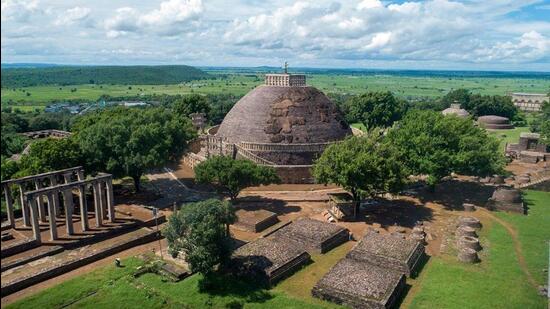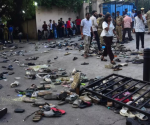HistoriCity: The story of Bhopal state’s role in preserving ancient heritage

Amid an onslaught of judicial orders to survey Muslim places of worship, the forgotten story of the role of the rulers of Bhopal to preserve the ancient Buddhist site of Sanchi is instructional. Except the renaming of Islam Nagar to its Jagdishpur in 2023 Bhopal has so far not witnessed a serious weaponization of history but the communal divide is a threat even in this largely peaceful city.

In popular imagination, Bhopal is infamous for the 1984 industrial disaster that killed over 5,000 people when the deadly Methyl isocyanate (MIC) gas leaked due to negligent management at the Union Carbide (now DuPont-owned Dow Chemicals) fertiliser plant. Lately, this beautiful city of lakes—there are over 10 —has also come to be known as the Tiger capital of India.
The princely history of the state has been often limited to fascination with the four Begums of Bhopal s (women rulers) whose reign lasted nearly a century—from 1819 to 1926, when Sultan Jahan Begum abdicated in favour of her son, Hamidullah Khan. And while they practiced the purdah, the Begums were stubborn champions of women’s education and commissioned the construction of several renowned schools and colleges and other works of public utility. Appearing in body-length chadors or veils, the Begums travelled the world, interacting with world leaders and imbibing knowledge of varied kinds.
When Sultan Jahan Begum (reign. 1901-1926) travelled to London to attend the coronation of King George V, she wore a full-length gown, which not only amused but offended the prissy British royals and the racist section of British press who carried derisive articles about her attire. Though Bhopal was a Muslim princely state, it showed a remarkable zeal to conserve and preserve heritage without discrimination based on religion. The contribution of the Bhopal state to maintain and popularise the ancient site of Sanchi, for instance, was crucial but rarely acknowledged.
Mesolithic Age to Mauryan Era Sanchi
Surrounded by clusters of Hindu and Gond villages, each having its own chief, Bhopal itself was barely a small village when Dost Mohammad Khan (1657-1728) decided to build the Fatehgarh fort along the great Upper Lake of the city. He had lost the Islamnagar fort to the Nizam of Hyderabad in 1723. While just a few remnants of the original fort survive, the area overlooking the lake remains the nucleus around which the city has grown over the last three centuries. Historical records about Bhopal prior to the 18th century are sparse and scattered. There’s indirect inscriptional and textual evidence and legends of the great lake having been constructed around the 11th century on the orders of the Parmar king, Bhoja (reign. 1010-1055) whose capital was at Dhar.
No inscriptions have been found in Bhopal so far that ascertain the name of the builder of the lake. Between Parmar rule, which ended during the Sultanate period, and the 18th century we find very few references to the Bhopal region, the most notable being the siege of the ancient fort of Raisen by Sher Shah Suri in the 16th century as part of his campaign to conquer Malwa.
But the dozens of pre-historic Mesolithic cave paintings found in and around Bhopal, such as the iconic Bhimbetka caves, make it clear that the region has been home to humans for at least 10,000 years. The most stunning evidence of human civilisation from Bhopal dates back more than 2,000 years to the Mauryan period when the great Buddhist complex was first constructed in nearby Sanchi under the orders of Ashoka, India’s first empire-builder. He fell in love with Devi, the daughter of a merchant from Vidisha. Later, their children, Sanghamitra and Mahindra, would carry Buddha’s relics to Sri Lanka and permanently establish Buddhism in the island nation.
Discovery of Sanchi
Colonial records tell us that it was the British who discovered the iconic site of Sanchi but that’s not entirely true. Locals were aware of the existence of mounds and temples on the set of hillocks that dot the region and continue to tempt the curious. Sanchi is one of the most significant sites as it provides a glimpse into various periods of Indian history beginning with the Mauryas (300 BCE-185 BCE), the Sungas, Satavahanas, the Kushans and the Western Satraps, and finally the Gupta period (300-600 CE).
Ashar Kidwai, assistant professor of history at Bhopal’s Saifia College, says, “The earliest mention of Sanchi in Bhopal state records dates back to 1718, when Dost Muhammad Khan, defeated a force of 2,000 soldiers led by the Mughal governor of Vidisha, Sher Muhammad Khan, who were entrenched at Sansi, which was another name for Sanchi.”
In 1818, Henry Taylor, a British officer, posted in the region during the Third Maratha War (1817-1819), first documented the existence of the Sanchi ‘topes’ which sparked interest among the British, leading to excavations that continued for over a century. Major Alexander Cunningham, who later became the first Director-General of Archaeological Survey of India (ASI), and was also the first Englishman to excavate Sanchi, wrote in 1851 in the Journal of the Royal Asiatic Society, “The large tope at Sanchi had been breached on the southern side by Sir Herbert Maddock about thirty years ago, but the centre of the building had not been reached. The second sized tope had also been breached, but, although the centre of the building must have been laid open no relics were obtained and these clumsy excavations were fortunately abandoned”.
Cunningham was the brother of J D Cunningham, the Political Agent to the state of Bhopal from 1846 to 1850, a fact instrumental in the younger Cunningham gaining access to Sanchi from Sultan Shah Jahan Begum, the then ruler of Bhopal.
Pillage versus Preservation
As was the prevalent custom, after the discovery of any ancient site in India, British officers shipped away the most precious artefacts to museums and buyers in England. Sanchi too was plundered with precision and its sculptures were auctioned away in distant lands.
The Bhopal rulers actively monitored the excavation work at Sanchi. Nawab Shah Jahan Begum (reign. 1844- 60 and 1868-1901) writes in Taj-ul Ikbal Tarikh Bhopal, “We visited Sanchi Khanakhera, and inspected the stone sculptures and statues of Budha, and the ancient gateway… Major Alexander Cunningham, brother of the late Captain J. D. Cunningham, formerly Political Agent of Bhopal, stayed several weeks in this neighbourhood, and examined these ruins most carefully. He took drawings of the place, deciphered the inscriptions, and bored shafts down these domes. The result of his investigations was described by him in an English work. The meaning of the word Sanchi in the Hindi language is calm or peace.”
Between 1822 and 1940s the British took away many famous sculptures such as the Sanchi Torso and made plans to transport the famous richly carved gateways to London. However, this didn’t happen because of the massive costs and risk of damage to the structure during extraction and transportation.
“While the Bhopal rulers couldn’t stop their British masters from shipping away artefacts, they did what they could: pay for the preservation of what was not taken, by providing security and maintenance, and clearing the site for the construction of a museum at Sanchi at the cost of over ₹10,000 in 1913,” said Kidwai. Colonial accounts also refer to an 1868 offer by Shah Jahan Begum to send the gateways, likely made under pressure exerted by British authorities. Bhopal state records do not attest to this claim.















